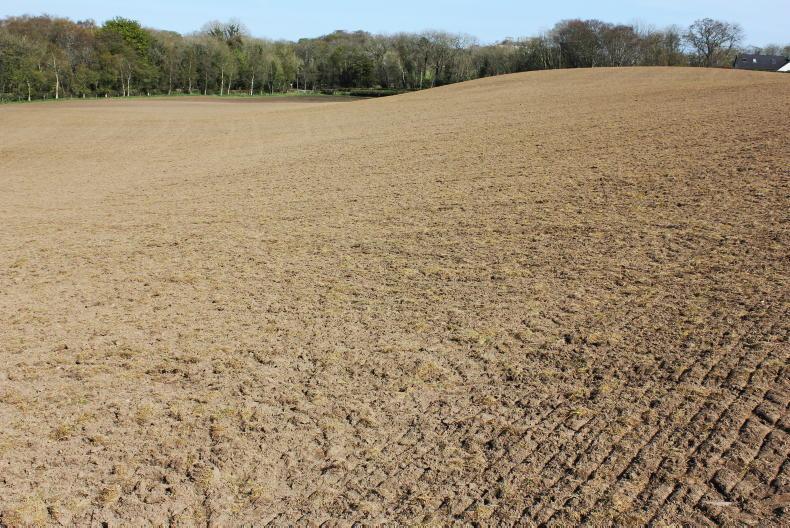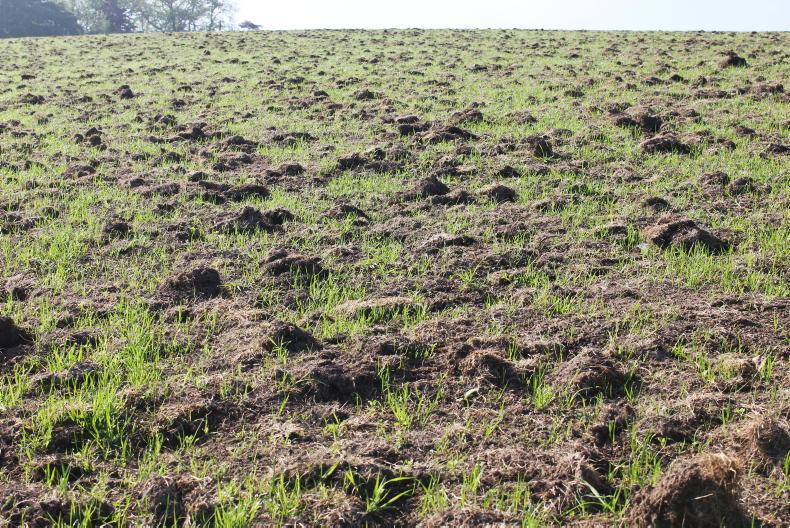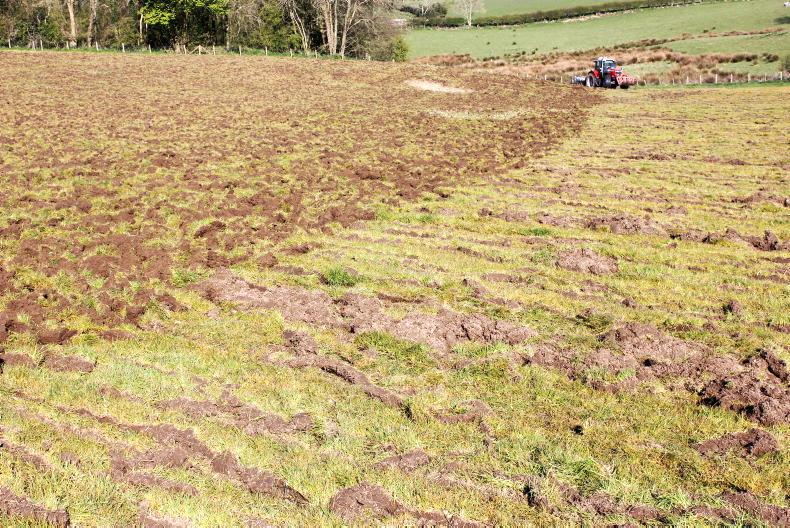A few weeks ago, I wrote about reseeding a 12ac field, and specifically dwelled on the choice of grass varieties that would best suit my system.
The other unusual factor concerned method of establishment, because I decided to prepare a seedbed without ploughing.
I deliberately chose not to say anything about this, because I reckoned by the end of May I’d be able to describe the whole process (accompanied by pictures) and everyone who read the story would be blown away by the agricultural brilliance of Derek Robinson.
Unsurprisingly, that’s not how things are turning out. Five weeks on from 24 April (sowing date), there’s a vague greenness across the field, but the cold spell of weather scuppered any plans for a quick turnaround.

After three passes with a heavy disc, one run of the power harrow and rolled with a Cambridge roller, it was coming into decent order.
Alternative
Despite being a firm advocate of the traditional ploughing method, I could see a few disadvantages, and reckoned this field was better suited to an alternative method.
Firstly, I remember gathering stones the last time we reseeded it, and each cultivation pass just brought them up like a crop of spuds.
Also, it runs down into a couple of acres of black soil, which is slow to dry in the spring (or all year, on occasion) and there was no question of ploughing these areas without waiting and hoping for a dry summer.
Nor is it a dry field, so the probability of trying to winter-graze ewes on a big wet sponge didn’t hold much appeal either.

The combination of dry weather after sowing and unusually cold weather translated into a very slow establishment period. This photo was taken five weeks after sowing.
Perfect
Initially, I reckoned a direct drill would be the perfect tool, but I wasn’t able to locate one locally, so the next option was a local contractor who uses a Guttler.
His advice was to burn off the old sward, then give it several passes with a heavy disc to create a decent amount of tilth, before power harrowing in front of the sower.
We did this, and therefore ended up with something that costs a similar amount to a ploughed reseed, but is a lot firmer, because only the top few inches of soil were disturbed. And the nature of the machinery meant that no stones were pulled up, which was a real bonus.
One small issue worthy of mention is the number of sods littering the field, which spoils the overall appearance, but may not negatively affect the outcome in the long-term.
It goes without saying that the crows are having a huge party every morning, playing ‘hunt the creepy crawly’ by lifting these sods and not replacing them. Perhaps it would be wise to roll it again at some point, since the plan is to cut it for silage.
Uneven
Germination is not as even as I would have liked, but it is early days, and very dry weather after sowing meant that all those wetter areas came away more quickly than the dry bits, which had to wait a couple of weeks for heavy rain.
I wasn’t too concerned about this delay, since the inclusion of slug pellets provides some sort of insurance policy.
Also, I was hoping that shallow cultivation might result in very few weeds, but that may not end happily. Dear knows how I’ll control them, since there is clover in the grass mix and our herbicide choice is almost useless – the latest one to be banned was 2.4 DB, which had a limited, but useful, range.
Establish
Waiting for grass seedlings to establish, tiller, and become a proper crop is one of those frustrating aspects of farming, especially if it’s a field that you rely on.
In a small farming system like mine, 12ac is a significant area of land, so a cold spring wasn’t really what I had planned for. Presumably some of these days it will explode out of the ground, and in a few months, I’ll wonder what all the anxiety was for. Here’s hoping.
Read more
The day I nearly gassed the dog
In search of a long-term reseed
A few weeks ago, I wrote about reseeding a 12ac field, and specifically dwelled on the choice of grass varieties that would best suit my system.
The other unusual factor concerned method of establishment, because I decided to prepare a seedbed without ploughing.
I deliberately chose not to say anything about this, because I reckoned by the end of May I’d be able to describe the whole process (accompanied by pictures) and everyone who read the story would be blown away by the agricultural brilliance of Derek Robinson.
Unsurprisingly, that’s not how things are turning out. Five weeks on from 24 April (sowing date), there’s a vague greenness across the field, but the cold spell of weather scuppered any plans for a quick turnaround.

After three passes with a heavy disc, one run of the power harrow and rolled with a Cambridge roller, it was coming into decent order.
Alternative
Despite being a firm advocate of the traditional ploughing method, I could see a few disadvantages, and reckoned this field was better suited to an alternative method.
Firstly, I remember gathering stones the last time we reseeded it, and each cultivation pass just brought them up like a crop of spuds.
Also, it runs down into a couple of acres of black soil, which is slow to dry in the spring (or all year, on occasion) and there was no question of ploughing these areas without waiting and hoping for a dry summer.
Nor is it a dry field, so the probability of trying to winter-graze ewes on a big wet sponge didn’t hold much appeal either.

The combination of dry weather after sowing and unusually cold weather translated into a very slow establishment period. This photo was taken five weeks after sowing.
Perfect
Initially, I reckoned a direct drill would be the perfect tool, but I wasn’t able to locate one locally, so the next option was a local contractor who uses a Guttler.
His advice was to burn off the old sward, then give it several passes with a heavy disc to create a decent amount of tilth, before power harrowing in front of the sower.
We did this, and therefore ended up with something that costs a similar amount to a ploughed reseed, but is a lot firmer, because only the top few inches of soil were disturbed. And the nature of the machinery meant that no stones were pulled up, which was a real bonus.
One small issue worthy of mention is the number of sods littering the field, which spoils the overall appearance, but may not negatively affect the outcome in the long-term.
It goes without saying that the crows are having a huge party every morning, playing ‘hunt the creepy crawly’ by lifting these sods and not replacing them. Perhaps it would be wise to roll it again at some point, since the plan is to cut it for silage.
Uneven
Germination is not as even as I would have liked, but it is early days, and very dry weather after sowing meant that all those wetter areas came away more quickly than the dry bits, which had to wait a couple of weeks for heavy rain.
I wasn’t too concerned about this delay, since the inclusion of slug pellets provides some sort of insurance policy.
Also, I was hoping that shallow cultivation might result in very few weeds, but that may not end happily. Dear knows how I’ll control them, since there is clover in the grass mix and our herbicide choice is almost useless – the latest one to be banned was 2.4 DB, which had a limited, but useful, range.
Establish
Waiting for grass seedlings to establish, tiller, and become a proper crop is one of those frustrating aspects of farming, especially if it’s a field that you rely on.
In a small farming system like mine, 12ac is a significant area of land, so a cold spring wasn’t really what I had planned for. Presumably some of these days it will explode out of the ground, and in a few months, I’ll wonder what all the anxiety was for. Here’s hoping.
Read more
The day I nearly gassed the dog
In search of a long-term reseed








 This is a subscriber-only article
This is a subscriber-only article










SHARING OPTIONS: